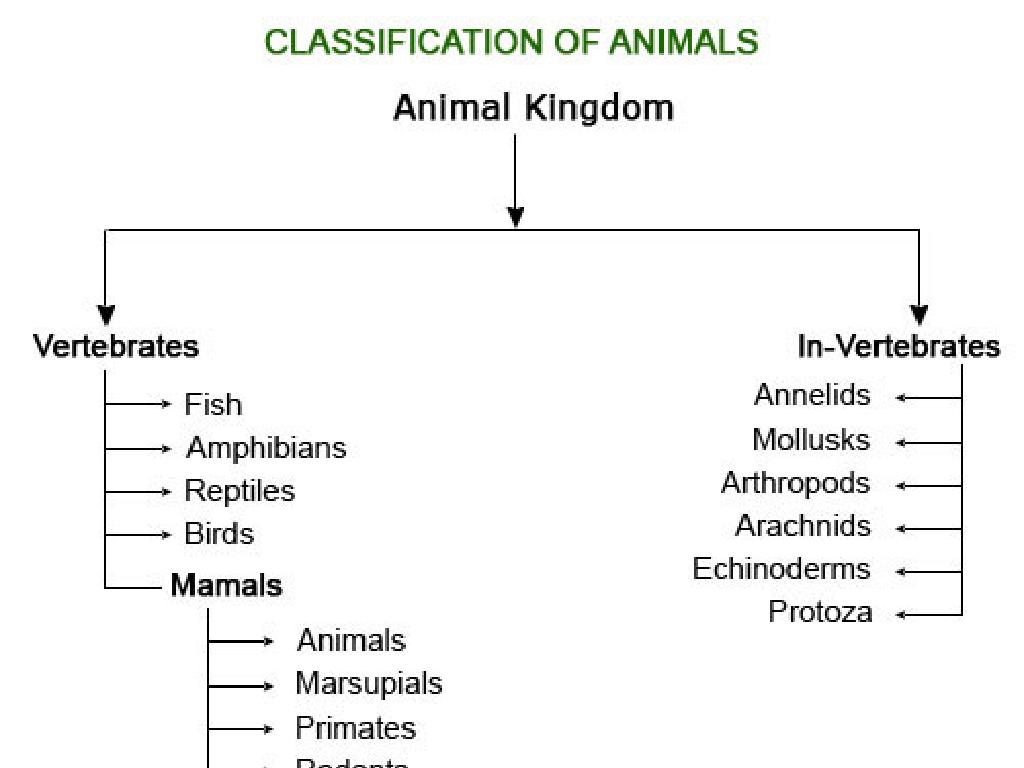Classify Symbiotic Relationships
Subject: Science
Grade: Eighth grade
Topic: Ecological Interactions
Please LOG IN to download the presentation. Access is available to registered users only.
View More Content
Exploring Symbiotic Relationships
– Define ecological interactions
– Interactions between organisms and their environment
– Importance in ecosystems
– They maintain ecosystem balance
– Introduction to symbiosis
– Symbiosis: close, long-term interactions
– Types of symbiotic relationships
– Mutualism, commensalism, parasitism
|
This slide introduces the concept of ecological interactions, emphasizing the importance of these relationships in maintaining the balance of ecosystems. Students will learn that symbiosis is a type of ecological interaction where two different species live in close, often long-term, association. Highlight the three main types of symbiotic relationships: mutualism, where both species benefit; commensalism, where one species benefits without harming the other; and parasitism, where one species benefits at the expense of the other. Provide examples for each type to help students understand the concepts better. Encourage students to think of additional examples from nature or their own experiences.
Exploring Symbiosis in Ecosystems
– Define symbiosis
– Symbiosis: a close, long-term interaction between different species.
– Symbiosis significance in ecosystems
– These interactions are crucial for the survival and health of many organisms.
– Examples of symbiotic relationships
– Mutualism: bees and flowers; Commensalism: barnacles on whales; Parasitism: ticks on mammals.
– Impact on natural world
|
This slide introduces the concept of symbiosis, which is a key component of ecological interactions. Symbiosis refers to a close and often long-term interaction between two different species. It’s important for students to understand that these relationships can be beneficial, neutral, or harmful to one or both parties involved. Highlight the importance of these interactions in maintaining the balance of ecosystems. Provide clear examples such as mutualism (bees pollinating flowers), commensalism (barnacles hitching a ride on whales), and parasitism (ticks feeding on mammals) to illustrate the different types of symbiotic relationships. Discuss how these relationships can affect the biodiversity and stability of the natural world. Encourage students to think of additional examples and consider the complex interdependencies in nature.
Types of Symbiotic Relationships
– Mutualism: Both species benefit
– Example: Bees pollinating flowers and getting nectar
– Commensalism: One benefits, other unaffected
– Example: Barnacles on whales; barnacles get transport, whales unaffected
– Parasitism: One benefits, other harmed
– Example: Ticks on dogs; ticks get blood, dogs may get diseases
|
This slide introduces students to the concept of symbiotic relationships within ecosystems, which is a key component of ecological interactions. Mutualism is a win-win situation where both organisms involved gain benefits, such as bees and flowers. Commensalism involves one organism benefiting while the other is neither helped nor harmed, like barnacles hitching a ride on a whale. Parasitism is a relationship where one organism benefits at the expense of the other, such as ticks feeding on a dog. Encourage students to think of additional examples and consider the complex interdependencies in nature. Discuss how these relationships can affect population dynamics and ecosystem health.
Mutualism in Symbiotic Relationships
– Mutualism: Bees and Flowers
– Bees collect nectar, pollinating flowers in the process
– Mutualism’s role in survival
– Both species benefit, enhancing each other’s chances of survival
– Clownfish and Sea Anemones
– Clownfish get protection, anemones get cleaning
|
This slide delves into the concept of mutualism, a type of symbiotic relationship where both organisms involved benefit. Using the example of bees and flowers, explain how bees collecting nectar for food help in the pollination of flowers, which is crucial for plant reproduction. Emphasize the importance of mutualism in the survival of species, as it often provides essential resources or services. Highlight the relationship between clownfish and sea anemones as another real-life example, where the clownfish are protected from predators by the anemones, and in return, clownfish clean the anemones and may provide nutrients through their waste. This mutualistic interaction showcases the intricate balance and interdependence found in ecosystems.
Commensalism in Depth
– Define commensalism in ecology
– One species benefits, the other is unharmed, e.g., birds nesting in trees.
– Birds and trees: a commensal pair
– Birds use trees for nesting without harming them, trees are unaffected.
– Find local commensal relationships
– Observe local ecosystems for similar non-harmful interactions.
– Case study: Barnacles on whales
– Barnacles travel and feed by attaching to whales, which aren’t affected.
|
Commensalism is a type of symbiotic relationship where one organism benefits while the other is neither helped nor harmed. An example to illustrate this is birds using trees as nesting sites. The birds gain a place to live, but the trees remain unaffected. Encourage students to explore their local environment to identify examples of commensalism, such as squirrels living in a tree. A case study of barnacles on whales can be discussed to show how these crustaceans hitch a ride and gain access to more feeding opportunities, while the whales typically don’t experience any negative effects. This slide aims to deepen the students’ understanding of ecological interactions and the delicate balance within ecosystems.
Parasitism in Symbiotic Relationships
– Effects of parasitism on hosts
– Parasites can harm host health, reproduction, or survival.
– Balancing parasitic interactions
– A delicate balance exists where parasites must not kill the host too quickly.
– Ticks as parasites on animals
– Ticks feed on blood, potentially transmitting diseases.
– Mistletoe’s impact on trees
– Mistletoe absorbs water and nutrients from host trees, weakening them.
|
This slide delves into parasitism, one of the three main types of symbiotic relationships. Parasitism negatively impacts host species by affecting their health, reproduction, or survival. It’s crucial to discuss the balance in parasitic relationships; parasites rely on their hosts for resources, but if they harm the host too much, it can lead to the death of both organisms. Examples include ticks, which can cause harm by feeding on the blood of animals and sometimes transmitting diseases like Lyme disease. Another example is mistletoe, a plant that attaches to trees and absorbs their water and nutrients, which can weaken or even kill the tree over time. Encourage students to think critically about the impact of parasitic relationships on ecosystems and the fine line parasites walk to survive without destroying their host.
Identifying Symbiotic Relationships
– Recognize symbiosis types
– Mutualism, Commensalism, Parasitism
– Characteristics of symbiosis
– Look for long-term interactions, mutual benefit, or harm
– Group activity: Classify examples
– Work in groups to identify relationships in given scenarios
|
This slide introduces students to the concept of symbiotic relationships within ecosystems. Students should learn to recognize the three main types of symbiosis: mutualism, where both species benefit; commensalism, where one species benefits without affecting the other; and parasitism, where one species benefits at the expense of the other. Key characteristics include the duration of the interaction and the nature of the benefits or harm experienced by the organisms involved. The group activity is designed to help students apply their knowledge by classifying examples of symbiotic relationships. Provide various scenarios or examples and ask the groups to discuss and determine the type of symbiosis present. This interactive approach will enhance their understanding and retention of the material.
Symbiosis in Our Lives
– Human impact on symbiosis
– How do our actions affect natural symbiotic relationships?
– Symbiosis in agriculture
– How do farmers use symbiotic principles to grow food?
– Symbiosis in medicine
– How do symbiotic organisms help in creating medicines?
– Conservation and symbiosis
– Why is understanding symbiosis vital for conservation efforts?
|
This slide aims to explore the significance of symbiotic relationships beyond natural ecosystems, particularly focusing on human influences and applications in agriculture and medicine. Discuss how human activities can disrupt or promote symbiotic relationships in nature. Highlight examples in agriculture where symbiotic relationships are harnessed for crop production, such as nitrogen-fixing bacteria with legumes. In medicine, discuss how bacteria in the human gut have a symbiotic relationship with us, aiding in digestion and health, and how this is leveraged for probiotic treatments. Lastly, emphasize the importance of symbiosis in conservation efforts, as understanding these relationships can lead to better strategies for preserving biodiversity and ecosystem health. Encourage students to think critically about how their actions can impact these delicate relationships and the importance of maintaining balance in nature.
Class Activity: Symbiosis Scavenger Hunt
– Understand the scavenger hunt rules
– Work in groups to find symbiosis examples
– Collaborate to identify real-life examples
– Document each symbiotic relationship
– Take notes or pictures as evidence
– Prepare to present and discuss findings
|
This class activity is designed to engage students in a hands-on learning experience about symbiotic relationships. Students will work in groups to search for and document examples of symbiosis in their local environment or from provided resources. They should look for instances of mutualism, commensalism, and parasitism. After the scavenger hunt, each group will present their findings to the class, facilitating a discussion on the different types of symbiotic relationships and their roles in ecosystems. Possible activities include observing birds nesting in trees (commensalism), bees pollinating flowers (mutualism), or ticks on a dog (parasitism). The goal is for students to apply their knowledge of symbiosis in a practical setting and to enhance their observational and teamwork skills.
Conclusion: Symbiotic Relationships in Ecosystems
– Recap of symbiotic relationships
– Mutualism, Commensalism, Parasitism
– Symbiosis significance in nature
– Symbiosis maintains ecosystem balance
– Introduction to food webs and chains
– Reflect on today’s learning
– Think about how different species rely on each other
|
This slide aims to summarize the key points from the lesson on symbiotic relationships, emphasizing the role these interactions play in maintaining the balance of ecosystems. Highlight examples of mutualism, commensalism, and parasitism to reinforce the concepts. Transition to the next topic by briefly introducing food webs and chains, explaining how they represent the flow of energy through an ecosystem and the interdependence of organisms. Encourage students to reflect on what they’ve learned and consider the complex interrelationships that exist in nature. Prepare them for the next lesson by connecting the concepts of symbiosis to the broader context of ecological interactions.






